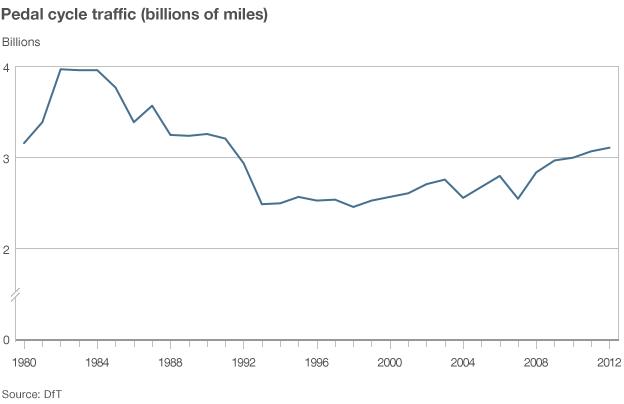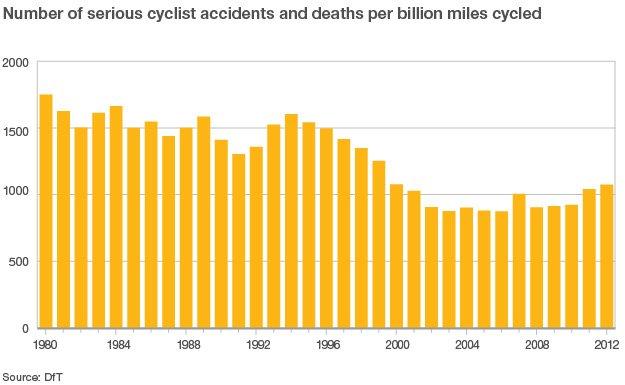Is cycling getting more or less dangerous?
- Published

A cyclist in south London has become the sixth to die in the capital in two weeks. Is cycling in the UK getting more dangerous?
There have been 14 deaths in London so far this year. In 2012 the figure was 14, in 2011 it was 16, and in 2010 it was 10, external, so it could be that this year ends on a broadly similar figure.
The number of deaths alone may be misleading, however, as the figures are too low to read a clear trend from. The Department for Transport (DfT) produces a more useful statistic - "KSIs", which represents both deaths and serious injuries.
Early statistics for the first half of 2013 have yet to be verified (for the last two years they have been revised down), so it's best to stick with the official figures until the end of 2012.
The DfT data shows a steady increase in KSIs in London over the last few years from 468 in 2010 to 673 in 2012, external. Across Britain (so excluding Northern Ireland) the number rises from 2,771 to 3,340, external.

Of course, these figures make no allowance for the number of miles cycled, which has also risen over the same period. The DfT attempts to measure that too, by counting the number and type of vehicles that pass particular markers on major roads throughout the year.
An additional 110 million miles were cycled in 2012 compared with 2010, up from 3.0 billion miles to 3.11 billion, external.
Taking this increase into account, it is possible to calculate the number of KSIs per billion miles cycled, and here the increase across Britain is much more gradual, from 923 in 2010 to 1,074 in 2012, external.
The real difference is likely to be narrower still - according to the DfT - because cyclists are more likely to use minor roads and cycle paths which aren't tracked by their vehicle counters.
In London, there has almost certainly been a dip in KSIs per billion miles. After all, many more cyclists have taken to the streets. Though Transport for London doesn't measure the number of miles covered, it does record the "number of trips per day" which has leapt 66% in 10 years from 0.3 million in 2001 to 0.5 million in 2011, external.
When viewed over the last three decades or so, a much clearer pattern emerges. Across Great Britain, KSIs per billion miles have almost halved since 1979, external, suggesting that the roads have become far safer for cyclists than they were around 30 years ago.

The graph shows a steady decline until the turn of the century when the figures begin to level off. But there is another way to look at it.
While the long-term trend does indeed point to improved safety, deaths and serious injuries have fallen for all road users - from drivers and cyclists to bus passengers and pedestrians.
Improved awareness of road safety and a raft of practical measures to curb road deaths have benefited everybody, and cyclists are by no means the main beneficiaries.
Looking at the number of KSIs per billion miles travelled for all road users (including pedestrians), it is clear that they have fallen faster and more consistently than for cyclists alone.
Since 1979 the figure - which is lower anyway because of the greater distances covered on statistically safer roads, like motorways - has fallen from 537 to 81, external.

Cycling may always pose some increased risk to the rider, but further improvements are still within reach.
Although they don't produce an equivalent "KSI" figure, the Dutch government does calculate the the number of fatalities per billion miles.
In 2012 there were 38 deaths per billion miles cycled in Britain - the fourth lowest year on record - but in the Netherlands the number was almost half that, at just 22. The Netherlands is well-known for spending more on cyclists.
As well as a healthier budget, cyclists in the Netherlands may also benefit from an effect known as "Smeed's Law" or "Safety in Numbers". In 1949 RJ Smeed, a British statistician, argued that as traffic density increased, motoring deaths would fall in relation to the number of vehicles on the road.
Many argue that the theory has been borne out for cyclists, too, linking the Netherlands' impressive safety record with its high proportion of cyclists.
If the sheer number of cyclists increases, the theory suggests, motorists will be more likely to adjust their driving to accommodate them.
Follow @BBCNewsMagazine, external on Twitter and on Facebook, external